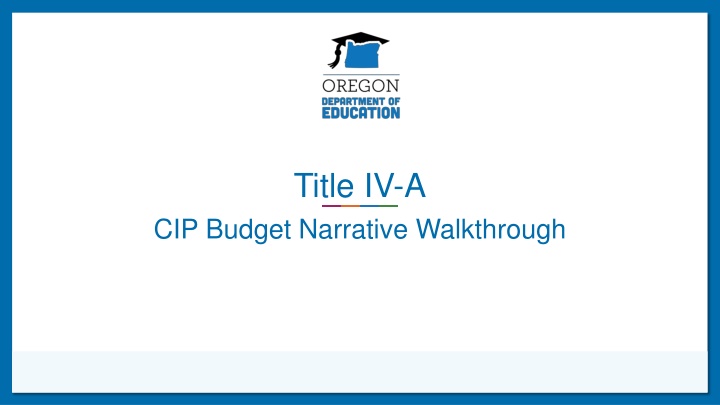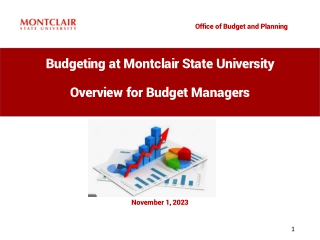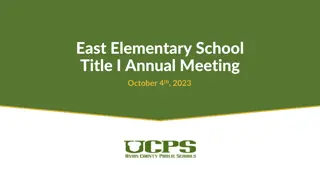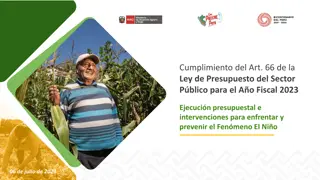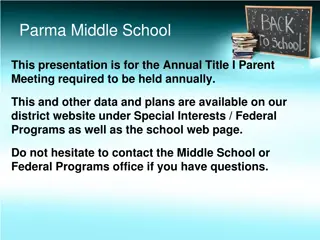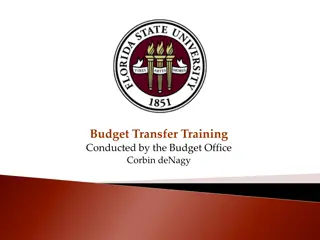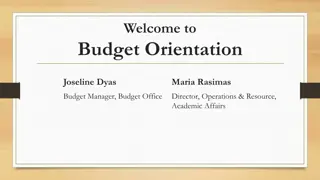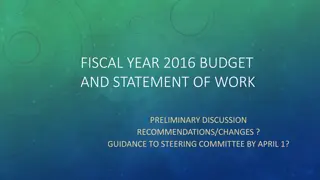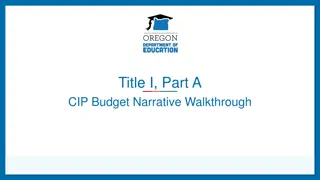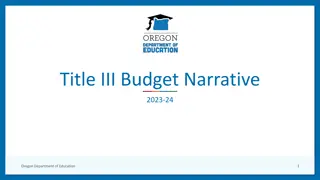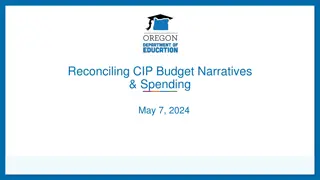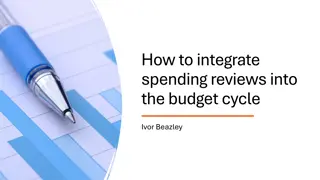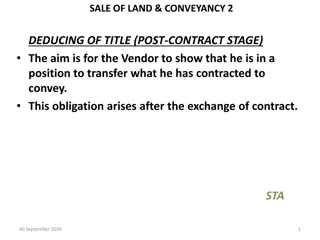Title IV-A CIP Budget Narrative - Outcomes and Guidelines
This walkthrough provides a comprehensive overview of the Title IV-A CIP budget narrative, including application requirements, allowable uses of funds, measuring progress, and more. Understand the purpose of Title IV-A, the importance of non-supplanting guidelines, and the timeline for federal funds in the 2024-25 grant period.
Download Presentation

Please find below an Image/Link to download the presentation.
The content on the website is provided AS IS for your information and personal use only. It may not be sold, licensed, or shared on other websites without obtaining consent from the author.If you encounter any issues during the download, it is possible that the publisher has removed the file from their server.
You are allowed to download the files provided on this website for personal or commercial use, subject to the condition that they are used lawfully. All files are the property of their respective owners.
The content on the website is provided AS IS for your information and personal use only. It may not be sold, licensed, or shared on other websites without obtaining consent from the author.
E N D
Presentation Transcript
Title IV-A CIP Budget Narrative Walkthrough
Outcomes for Today Walkthrough application requirements Understand allowable uses of funds Share requirements for measuring progress and public reporting Provide resources Oregon Department of Education 2
The purpose of Title IV-A is to improve student academic achievement through: Access to a well-rounded education; Purpose of Title IV-A Improved school conditions regarding the health and safety of students; and Improved use of technology in order to improve the digital literacy of all students. Oregon Department of Education 3
Supplement Not Supplant Federal funds cannot be used to supplant, or take the place of, state and local funds that would have been spent if Title IV-A funds were not available Test I: Are the services that the district wants to fund with ESEA funds required under state, local, or another federal law? If they are, there could be the presumption of supplanting. Test II: Were state or local funds used in the last year to pay for these services? If they were, there could be a presumption of supplanting. ESSA Quick Reference Brief: Supplement Not Supplant Oregon Department of Education 4
JULY 2024 AUG 2024 NOV 2024 2024-25 FEDERAL FUNDS TIMELINE 2024-25 BUDGET NARRATIVES DUE 2024-25 BUDGET NARRATIVE APPLICATION OPENS BEGINNING OF 2024-25 GRANT PERIOD NOV 2025 SEPT 2025 FINAL DATE FOR ALL 2024-25 CLAIMS FOR *INITIAL GRANT PERIOD FINAL DATE FOR OBLIGATION OF 2024-25 FUNDS FOR *INTIAL GRANT PERIOD NOV 2025 UNCLAIMED FUNDS BECOME CARRYOVER NOV 2025 NOV 2026 SEPT 2026 *INITIAL GRANT PERIOD: 7/1/24 9/30/25 (15 MONTHS) CARRYOVER APPLICATIONS FOR 2024-25 FUNDS OPEN FINAL DATE FOR OBLIGATION OF 2024- 25 FUNDS FINAL DATE FOR ALL 2024-25 GRANT CLAIMS Oregon Department of Education 5
Application Requirements Title IV-A CIP Budget Narrative Oregon Department of Education 6
Accessing the CIP Budget Narrative Login to the District Secure website Choose CIP Budget Narrative from the Applications list If you do not have access to the CIP Budget Narratives, reach out to your district Security Administrator Oregon Department of Education 7
Title IV-A Application Components Needs Assessment What does the data tell us? What are our outcomes and objectives? Budget Narrative What will we do to meet our needs? Equitable Services Worksheet Only for districts with participating schools Oregon Department of Education 8
Districts must meaningfully consult with a wide array of stakeholders when designing their SSAE programs Consultation & Engagement They must also engage in continuing consultation with stakeholders to improve SSAE activities and to coordinate SSAE activities with other activities conducted in the community Consultation as part of IG work counts! Watch for allowability and supplement not supplant Oregon Department of Education 9
Needs Assessment Only required for districts that receive $30,000 or more Identified Needs and Priorities Program Objectives and Intended Outcomes Must be completed even if the district plans to transfer funds into other programs Consult with stakeholders prior to transfer Prioritizing Schools Oregon Department of Education 10
Prioritizing High Needs Schools LEAs must prioritize SSAE funds to schools that Have the greatest need as determined by the LEA Have the highest percentages or numbers of children experiencing poverty Are identified for CSI or TSI support Are identified as a persistently dangerous school under Section 8532 Oregon Department of Education 11
Completing the Budget Narrative WHY was the strategy/activity selected? List the prioritized need the activity addresses WHAT is the intended objective? Briefly describe the activity WHO is participating? List the audience for the activity (e.g.; staff, students) HOW will you measure impact? Identify what measures will be used to determine whether the strategy is generating the results you expect Oregon Department of Education 12
Equitable Services Create aline item in the narrative for each participating school Date of initial consultation Total equitable services amount from worksheet District must approve school activities Activities, evaluation of impact and expenditure reports for equitable services will be shared with ODE as part of the monitoring process Oregon Department of Education 13
Allowable Uses Oregon Department of Education 14
Allowable Costs Under Title IV-A Well-Rounded Education Safe and Healthy Students Use of Technology College & career guidance Music & Arts STEM Accelerated learning History, civics, economics, geography, government education Foreign language Environmental education Volunteerism & community involvement Integrating multiple disciplines Drug & violence prevention School-based mental health services Health & safety programs Addressing trauma Addressing sexual abuse Reducing exclusionary discipline practices Positive behavioral interventions Resource coordinator Pay for success Professional learning Technological capacity & infrastructure Delivering courses through technology Blended learning PD on use of technology in STEM areas Access to digital learning Oregon Department of Education 15
Spending Requirements by Category Well-Rounded Education (WRE) 20%* Provide enriched curriculum and education experiences to all students Remove barriers to courses and educational opportunities Safe and Healthy Students (SHS) 20%* Improve school conditions for student learning Help students feel safe and supported Use of Technology (TECH) 15% cap on technology infrastructure Improve the academic achievement, academic growth, and digital literacy of all students. Accelerate, amplify and expand on effective practices that support student learning * Applies to districts that receive $30,000 or more in IV-A funds Oregon Department of Education 16
Devices Equipment Software applications and platforms Digital instructional resources Other one-time IT purchases Defining Technology Infrastructure Private school equitable share for all buckets is part of the district s percentage, including technology infrastructure Oregon Department of Education 17
A note about mental health supports SEC. 4001. 20 U.S.C. 7101 GENERAL PROVISIONS (a) PARENTAL CONSENT. (1) IN GENERAL. (A) INFORMED WRITTEN CONSENT. A State, local educational agency, or other entity receiving funds under this title shall obtain prior written, informed consent from the parent of each child who is under 18 years of age to participate in any mental-health assessment or service that is funded under this title and conducted in connection with an elementary school or secondary school under this title. (B) CONTENTS. Before obtaining the consent described in subparagraph (A), the entity shall provide the parent written notice describing in detail such mental health assessment or service, including the purpose for such assessment or service, the provider of such assessment or service, when such assessment or service will begin, and how long such assessment or service may last. Oregon Department of Education 18
Measuring Progress What need(s) are you trying to meet? (Priority/Goal) What action(s) will you take to meet that goal? (Objective) What do you expect to happen? (Outcome) How will you know? (Measure) How can we use what we learned through Integrated Guidance work? Oregon Department of Education 19
Public Reporting Oregon Department of Education 20
Resources Title IV-A web page USED Non-Regulatory Guidance Oregon Federal Funds Guide CIP Budget Narrative User Guide CIP Budget Narrative Checklists Humanities Education STEM and CTE Oregon Department of Education 21
Please reach out! Amy Tidwell amy.tidwell@ode.oregon.gov Jen Engberg jennifer.engberg@ode.oregon.gov Lisa Plumb lisa.plumb@ode.oregon.gov Sarah Martin sarah.martin@ode.oregon.gov Oregon Department of Education 22
Regional Contacts by ESD Amy Tidwell o Grant, Harney, High Desert, InterMountain, Jefferson, North Central and Region 18 Jen Engberg Clackamas, Columbia Gorge, Multnomah and Northwest Regional Lisa Plumb Lane, Linn Benton Lincoln and Willamette Sarah Martin Douglas, Lake, Malheur, South Coast and Southern Oregon Oregon Department of Education 23
